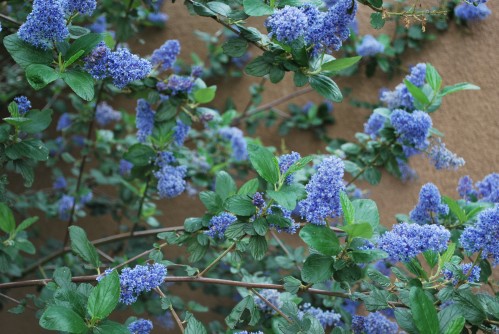 What is blooming in my garden now. My Ceanothus, or California's wild lilac. Sometimes it is hard to find pretty shades of blue colors for your garden. Usually blooming in late winter or early spring, the Ceanothus heralds "spring is coming." This drought tolerant California native is delightful. I always look forward to its profuse blue blooms in my garden each year.
What is blooming in my garden now. My Ceanothus, or California's wild lilac. Sometimes it is hard to find pretty shades of blue colors for your garden. Usually blooming in late winter or early spring, the Ceanothus heralds "spring is coming." This drought tolerant California native is delightful. I always look forward to its profuse blue blooms in my garden each year.
Ceanothus, an evergreen shrub, comes in many varieties, shapes, and blue color flower spikes. Some Ceanothus varieties are low and spreading, others are shrubby and bushy, and like my Ceanothus Ray Hartman, some have a tendency to grow upright and can be groomed into small trees. Flower colors range from pale blues to deep dark violet blues. There is even a Ceanothus with white blooms. Each variety has its own unique color. Their spike-blooms are showy and long-lived.
Ceanothus are very easy to care for and generally low maintenance shrubs. Ceanothus like full sun, and very little water. Avoid when planting Ceanothus, drip irrigation, summer water, and soil amendments. As a California native they prefer to be dry, and rely on our natural rainfall. Prune discreetly after their bloom time.
Don't be afraid to get "Blue in the Garden," think of the dramatic Ceanothus. They thrive in zones 5-9, 14-24. You won't be disappointed. Please share if you have Ceanothus in your garden. Please comment on your favorite Ceanothus.
VintageGardenGal Tidbit Thyme....
On Friday, March 18 at 4:00 p.m., national partners (Plant A Row for the Hungry, Garden Writers Association, The Scotts Miracle-Gro Company, Keep America Beautiful, National Gardening Association and Franklin Park Conservatory) will join Los Angeles Mayor Antonio Villaraigosa in the dedication of a series of reading, learning and community gardens in East Los Angeles. The installation event is part of the recently launched GRO1000 gardening and green spaces initiative and helps to kick off Keep Los Angeles Beautiful's Great American Cleanup.
This garden event will be held at the Proyecto Pastoral Community Center in the Boyle Heights neighborhood of East Los Angeles, 135 North Mission Road, Los Angeles. Approximately 200 area students, as well as members of the Guadalupe Homeless Project, will join Mayor Villaraigosa and GRO1000 national and local partners in the garden installation and dedication. One deserving student at the event will also be presented with the national Give Back To Gro Youth Gardener Award.
GRO1000 is a partnership committed to the establishment of 1,000 community gardens and green spaces over the next seven years throughout the United States and abroad. The initiative seeks to broaden the opportunities for individuals and communities to experience the benefits of community gardening and access to green spaces.

 In celebration of Sunset's newly released book later this month,
In celebration of Sunset's newly released book later this month,  , Sunset is hosting a special
, Sunset is hosting a special 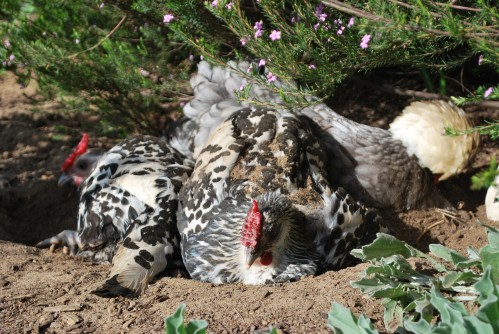 It is blissful when all of your hens get along easily. My three hens, Charley, Dolly, and Dahlia have been together since they were day old chicks. They get along famously, and move around in my garden as a unit. They are never far from one another. It was special to find them all together in the warm sandy soil under one of my Pink Breath of Heaven shrubs.
It is blissful when all of your hens get along easily. My three hens, Charley, Dolly, and Dahlia have been together since they were day old chicks. They get along famously, and move around in my garden as a unit. They are never far from one another. It was special to find them all together in the warm sandy soil under one of my Pink Breath of Heaven shrubs. Maybe I should have titled this post, cooking with one of my favorite authors. When
Maybe I should have titled this post, cooking with one of my favorite authors. When  books until she mentioned in our cooking class she has authored and co-authored over 30 books. Hearing that, reinforces my esteemed opinion of her as a forceful food visionary, placing her alongside Alice Waters, Rosalind Creasy, Michael Pollan, and distinguished others.
books until she mentioned in our cooking class she has authored and co-authored over 30 books. Hearing that, reinforces my esteemed opinion of her as a forceful food visionary, placing her alongside Alice Waters, Rosalind Creasy, Michael Pollan, and distinguished others.
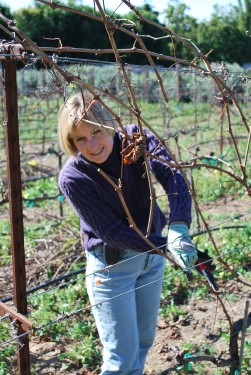 My husband, John, and I like to have our backyard syrah vineyard here in Southern California pruned by early February or Super Bowl time frame. It is a necessary and important annual task for the vineyard. At this point in the year, the vines are dormant and barren with no leaves to be seen. The vineyard has its own structural beauty showing the trunks and cordons of each vine.
My husband, John, and I like to have our backyard syrah vineyard here in Southern California pruned by early February or Super Bowl time frame. It is a necessary and important annual task for the vineyard. At this point in the year, the vines are dormant and barren with no leaves to be seen. The vineyard has its own structural beauty showing the trunks and cordons of each vine.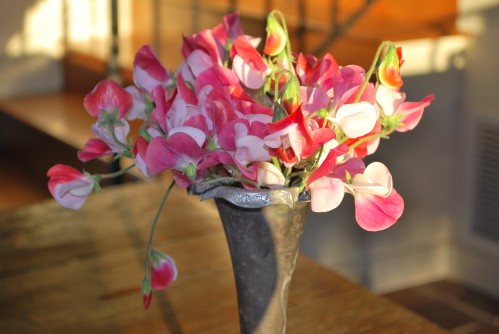 Yesterday, I cut and gathered this wonderful bouquet of sweet peas out of my garden. The first beautiful bouquet of sweet peas for this year. If you plant sweet peas each year, chances are you are going to have early sweet peas, even in February. It has been a few years since I had my hands on the original seed packet, but I think these are the
Yesterday, I cut and gathered this wonderful bouquet of sweet peas out of my garden. The first beautiful bouquet of sweet peas for this year. If you plant sweet peas each year, chances are you are going to have early sweet peas, even in February. It has been a few years since I had my hands on the original seed packet, but I think these are the 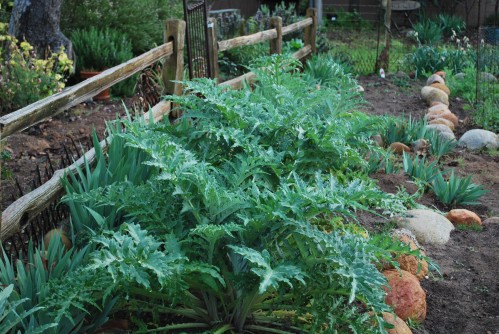 With all of the winter rains we've had here in Southern California, my artichokes have blossomed quickly into new plants. Artichokes in zone 9 are a perennial. It is recommended to plant them in the back of your potager or kitchen garden so as not to take away sunlight from other shorter plants growing. Artichokes are so structural at 4 feet high x 6-8 feet wide, they can easily be planted throughout your gardens and in key focal points, too.
With all of the winter rains we've had here in Southern California, my artichokes have blossomed quickly into new plants. Artichokes in zone 9 are a perennial. It is recommended to plant them in the back of your potager or kitchen garden so as not to take away sunlight from other shorter plants growing. Artichokes are so structural at 4 feet high x 6-8 feet wide, they can easily be planted throughout your gardens and in key focal points, too.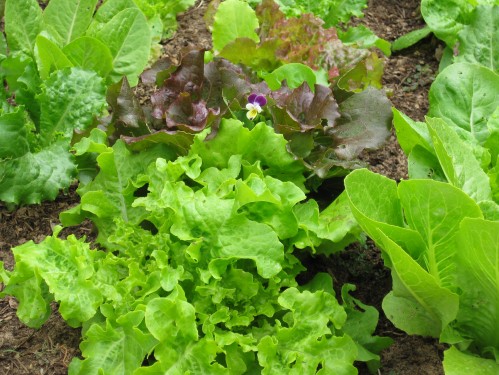 January and February are optimum months for planting lettuce from seed, according to Charles B. Ledgerwood's Southern California Vegetable Planting Calendar. Here are other his other suggestions, optimum plantings for the month are capitalized.
January and February are optimum months for planting lettuce from seed, according to Charles B. Ledgerwood's Southern California Vegetable Planting Calendar. Here are other his other suggestions, optimum plantings for the month are capitalized.